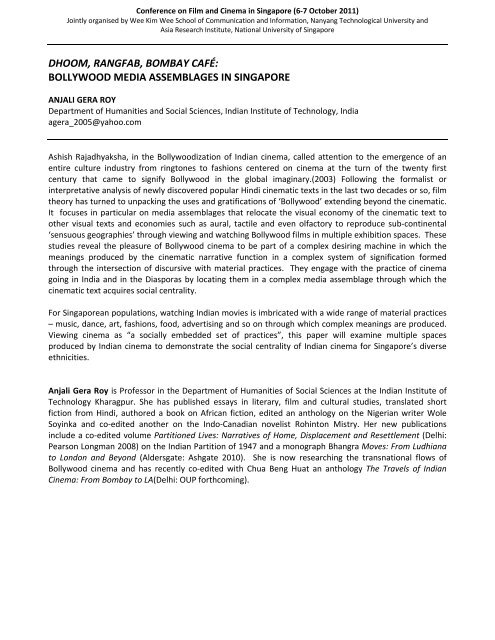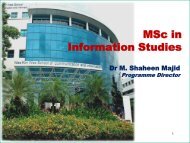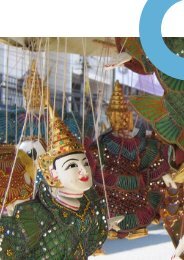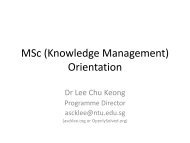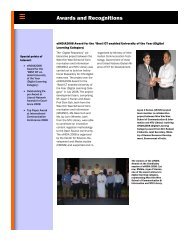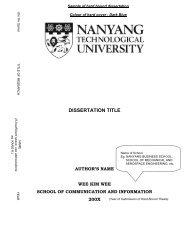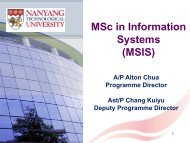Programme and Abstracts 4 Oct 2011 - WKWSCI Home - Nanyang ...
Programme and Abstracts 4 Oct 2011 - WKWSCI Home - Nanyang ...
Programme and Abstracts 4 Oct 2011 - WKWSCI Home - Nanyang ...
Create successful ePaper yourself
Turn your PDF publications into a flip-book with our unique Google optimized e-Paper software.
Conference on Film <strong>and</strong> Cinema in Singapore (6‐7 <strong>Oct</strong>ober <strong>2011</strong>)<br />
Jointly organised by Wee Kim Wee School of Communication <strong>and</strong> Information, <strong>Nanyang</strong> Technological University <strong>and</strong><br />
Asia Research Institute, National University of Singapore<br />
DHOOM, RANGFAB, BOMBAY CAFÉ:<br />
BOLLYWOOD MEDIA ASSEMBLAGES IN SINGAPORE<br />
ANJALI GERA ROY<br />
Department of Humanities <strong>and</strong> Social Sciences, Indian Institute of Technology, India<br />
agera_2005@yahoo.com<br />
Ashish Rajadhyaksha, in the Bollywoodization of Indian cinema, called attention to the emergence of an<br />
entire culture industry from ringtones to fashions centered on cinema at the turn of the twenty first<br />
century that came to signify Bollywood in the global imaginary.(2003) Following the formalist or<br />
interpretative analysis of newly discovered popular Hindi cinematic texts in the last two decades or so, film<br />
theory has turned to unpacking the uses <strong>and</strong> gratifications of ‘Bollywood’ extending beyond the cinematic.<br />
It focuses in particular on media assemblages that relocate the visual economy of the cinematic text to<br />
other visual texts <strong>and</strong> economies such as aural, tactile <strong>and</strong> even olfactory to reproduce sub‐continental<br />
‘sensuous geographies’ through viewing <strong>and</strong> watching Bollywood films in multiple exhibition spaces. These<br />
studies reveal the pleasure of Bollywood cinema to be part of a complex desiring machine in which the<br />
meanings produced by the cinematic narrative function in a complex system of signification formed<br />
through the intersection of discursive with material practices. They engage with the practice of cinema<br />
going in India <strong>and</strong> in the Diasporas by locating them in a complex media assemblage through which the<br />
cinematic text acquires social centrality.<br />
For Singaporean populations, watching Indian movies is imbricated with a wide range of material practices<br />
– music, dance, art, fashions, food, advertising <strong>and</strong> so on through which complex meanings are produced.<br />
Viewing cinema as “a socially embedded set of practices”, this paper will examine multiple spaces<br />
produced by Indian cinema to demonstrate the social centrality of Indian cinema for Singapore’s diverse<br />
ethnicities.<br />
Anjali Gera Roy is Professor in the Department of Humanities of Social Sciences at the Indian Institute of<br />
Technology Kharagpur. She has published essays in literary, film <strong>and</strong> cultural studies, translated short<br />
fiction from Hindi, authored a book on African fiction, edited an anthology on the Nigerian writer Wole<br />
Soyinka <strong>and</strong> co‐edited another on the Indo‐Canadian novelist Rohinton Mistry. Her new publications<br />
include a co‐edited volume Partitioned Lives: Narratives of <strong>Home</strong>, Displacement <strong>and</strong> Resettlement (Delhi:<br />
Pearson Longman 2008) on the Indian Partition of 1947 <strong>and</strong> a monograph Bhangra Moves: From Ludhiana<br />
to London <strong>and</strong> Beyond (Aldersgate: Ashgate 2010). She is now researching the transnational flows of<br />
Bollywood cinema <strong>and</strong> has recently co‐edited with Chua Beng Huat an anthology The Travels of Indian<br />
Cinema: From Bombay to LA(Delhi: OUP forthcoming).


